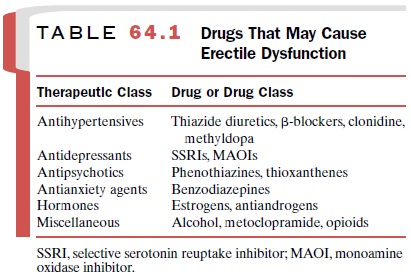Chapter: Modern Pharmacology with Clinical Applications: Drugs Used in the Treatment of Erectile Dysfunction
Drugs Used in the Treatment of Erectile Dysfunction
Drugs Used
in the Treatment of Erectile Dysfunction
The term impotence has been
used to indicate the inability of the male to attain and maintain erection of
the penis sufficient to permit satisfactory sexual inter-course. Erectile
dysfunction (ED) is the preferred term. ED is a common problem, especially among
older men. Perhaps a more precise term for ED is that used to sig-nify
inability of the man to achieve an erect penis as part of the multifaceted
process of male sexual func-tion. Overall, the process encompasses a variety of
physical aspects with significant psychological and be-havioral components.
In the United States
approximately 10 million men have ED. While erectile function may not be the
most important indicator of sexual satisfaction, ED may con-tribute to mental
stress that affects interactions with family and associates. While many
advances have oc-curred in the diagnosis and treatment of ED, other aspects
remain poorly understood by the general popu-lation and even health care
professionals. ED is fre-quently assumed to be a physiological event associated
with aging, but that is not entirely accurate.
The incidence of ED can be as
high as 50% in men aged 40 to 70, with the percentage increasing with age.
Other risk factors associated with ED include chronic illnesses, medications,
cigarette smoking, heavy alcohol consumption, sedentary patterns, and obesity.
ED can be due to vasculogenic, neurogenic, hormonal, and/or psychogenic
factors. It can also be due to changes in the nitric acid–cyclic guanosine
monophosphate (cGMP) biochemical pathway.
Most cases of secondary ED
are related to arte-riosclerosis. ED is also associated with hypertension,
an-tihypertensive therapy, and diabetes mellitus, particu-larly in the older
diabetic. Other chronic diseases, such as psychogenic disorders and Peyronie’s
disease, may be associated with ED.
Several therapeutic agents,
especially those that af-fect neurotransmitter activity (both agonist and
antago-nist) are often associated with ED. Many such reports have been
anecdotal, although 25% of ED may be drug-related. Several classes of drugs
have been associated with ED (Table 64.1). The mechanism or mechanisms of

ED seems to be most frequently associated with antihypertensive medications, particularly β-blockers and thiazide diuretics. Estrogen therapy and the use of antiandrogens can lead to changes in the endocrine system resulting in ED. Paradoxically, selective serotonin reuptake inhibitors (SSRIs) can be associated with ED while also being useful be for the treatment of premature ejaculation.
Erection involves a
coordinated action of the auto-nomic nervous system, and certain drugs may
interfere with either the sympathetic division (e.g., α1- receptors) or the parasympathetic
division (e.g., noncholinergic neurotransmitters).
Related Topics